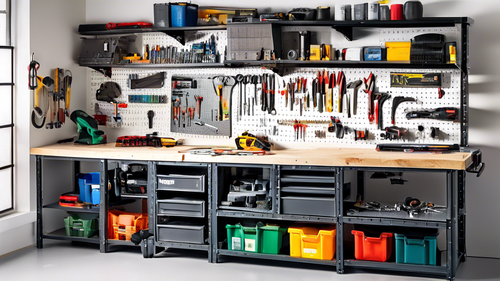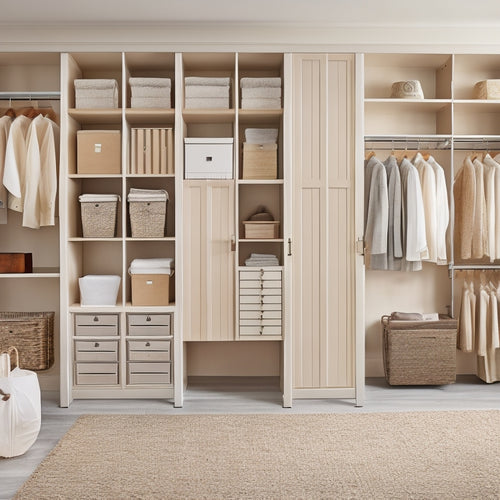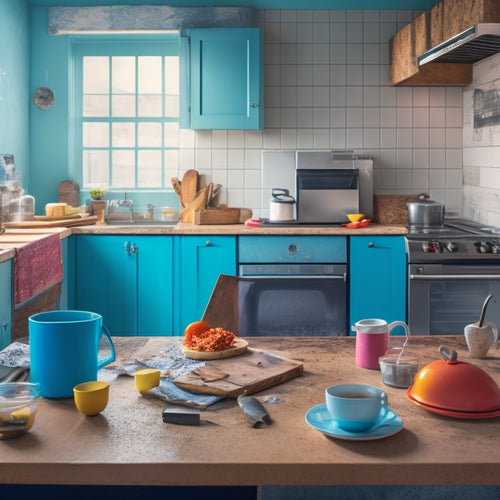
Maximize Your Kitchen: 10 Decluttering Hacks
Share
You're likely wasting up to 30 minutes a day searching for misplaced kitchen items, and it's time to take back control of your cooking space. Start by purging kitchen countertop clutter, implementing a "one in, one out" policy, and optimizing cabinet storage space. Employ vertical wall storage, create functional zones like a spice station and coffee zone, and invest in multifunctional tools. Assign a home for everything, label clearly, and schedule regular kitchen maintenance. By following these decluttering hacks, you'll save time and reduce stress in the kitchen. Now, get ready to unfasten even more efficient cooking habits.
Key Takeaways
- Purge kitchen countertops by categorizing items into "keep," "donate," and "toss" to create a more organized and efficient space.
- Implement a "one in, one out" policy to prevent clutter accumulation and maintain a balanced kitchen inventory management system.
- Optimize storage solutions by utilizing vertical space, installing hanging racks, and assigning a home for everything to increase storage capacity.
- Label everything clearly using color-coding, categorization, and labeling techniques to ensure easy access to specific ingredients and maintain a clutter-free kitchen.
- Schedule regular kitchen maintenance by creating a checklist for daily, weekly, and monthly tasks to maintain a clean, organized, and efficient kitchen.
Purge Kitchen Countertop Clutter
Purge Kitchen Countertop Clutter
Tackle the cluttered countertops by clearing everything off and sorting items into categories, such as "keep," "donate," and "toss." This step helps you visualize the space and identify what's truly essential.
Be ruthless – if you haven't used it in the past year, it's likely taking up significant space. Identify your countertop essentials, the must-haves that make your kitchen functional.
Consider the aesthetic minimalism you want to achieve and prioritize items that serve a purpose while maintaining a clean look. To maintain momentum, focus on small areas and discard unused items, adopting a one in, one out policy to prevent new clutter accumulation.
Once you've purged the unnecessary items, wipe down the countertops and reassess the layout. This fresh start will help you create a more organized, efficient kitchen.
Optimize Cabinet Storage Space
You're now ready to tackle the often-overwhelming task of optimizing your cabinet storage space.
Start by purging unwanted items that are taking up precious real estate, then think vertically to maximize the space you have.
Purge Unwanted Items
Cluttered cabinets can be overwhelming, a weight that's holding you back from cooking with ease.
It's time to purge unwanted items and take control of your kitchen. Start by removing everything from your cabinets and sorting items into three piles: keep, donate, and dispose.
Be ruthless – if you haven't used it in the past year, it's probably safe to get rid of it. Donate duplicates or items that are still in good condition, and dispose of expired or broken items.
Consider the 80/20 rule: 80% of the time, you likely only use 20% of your kitchen items. By purging the rest, you'll free up space and make cooking more efficient.
Utilize Vertical Space
Your kitchen cabinets, once a chaotic mess, are now a blank canvas waiting for optimization.
It's time to maximize your vertical space. Install shelf risers to double or triple your storage capacity. This will allow you to store less frequently used items, like special occasion dishes or cookbooks, while keeping everyday essentials within easy reach.
Consider hanging racks for pots, pans, or utensils, freeing up shelf space for other items. By utilizing vertical space, you'll create a more organized and efficient kitchen.
Remember to assess your cabinet's unique dimensions and adjust your storage solutions accordingly. With a little creativity, you'll be amazed at how much more you can fit in your kitchen cabinets.
Label Everything Clearly
With your cabinets now optimized for vertical storage, it's time to tackle the contents themselves.
Labeling everything clearly is key to maintaining a clutter-free kitchen. Use labeling techniques that work for you, such as color-coding or categorizing by type. This guarantees clear visibility of what's inside each container or shelf, making it easy to find what you need when you need it.
Label the contents of jars, baskets, and bins, as well as the shelves and containers themselves. This way, you'll avoid digging through cluttered shelves or wasting time searching for a specific ingredient.
Utilize Vertical Wall Storage
Optimizing your kitchen's vertical space is a game-changing element in the decluttering process. By utilizing wall-mounted shelves, you can clear countertops and create a sense of openness.
Install shelves near the ceiling to store infrequently used items, like special occasion dishes or cookbooks. For smaller items, consider magnetic strips to hold spices, oils, or utensils, keeping them organized and within reach.
Make the most of the space between your countertops and cabinets by adding a pegboard or a utensil organizer. This will keep frequently used items, like pots, pans, and utensils, neatly organized and easily accessible.
Create a Spice Station
Now that you've freed up precious counter space by utilizing vertical wall storage, it's time to tackle the often-daunting task of organizing your spices.
Create a spice station by designating a specific area, like a drawer or cabinet, for your spice collection. Use dividers or small containers to categorize spices by type, such as baking, savory, or sweet. This will allow you to easily find the perfect flavor to complement your dish.
Consider a rotating spice rack or a magnetic strip to maximize storage and accessibility.
With your spices organized, you'll be able to investigate a wider flavor variety and enhance your cooking game.
Designate a Coffee Zone
Your morning coffee routine just got a whole lot easier! By designating a coffee zone in your kitchen, you'll save time and reduce clutter.
Start by identifying your coffee station essentials, such as a coffee maker, grinder, and filters. Consider your brewing method preferences - do you prefer drip, French press, or pour-over?
Once you've gathered your essentials, assign a specific spot for each item. This could be a corner counter, a shelf, or even a cart.
Group similar items together and store them in a designated container or basket. Label each item so you can easily find what you need.
With a dedicated coffee zone, you'll be sipping your morning brew in no time.
Streamline Kitchen Drawer Organization
Frequently, kitchen drawers become a catch-all for various utensils, gadgets, and accessories, leading to clutter and disorganization. To regain control, you need a systematic approach to streamlining your kitchen drawer organization.
-
Assign a specific drawer for utensils, gadgets, and accessories
-
Use drawer dividers to separate items into categories (e.g., baking, cooking, serving)
-
Invest in utensil trays or inserts to keep frequently used items accessible
-
Store infrequently used items, like special occasion dishes, in harder-to-reach areas
-
Implement a "home for each item" rule to maintain organization and prevent clutter buildup
Implement a "One In, One Out" Policy
When you bring a new item into your kitchen, you'll need to get rid of an old one to maintain balance.
This "one in, one out" policy helps you stay mindful of your kitchen essentials and prevents clutter from building up again.
New Item Alert
As you bring new kitchen gadgets and utensils into your home, remember that clutter can quickly accumulate if you're not mindful of the items you already own. To maintain a clutter-free kitchen, adopt a "one in, one out" policy. This means that for every new item you bring in, you must remove or donate an old one.
This will prevent clutter from building up and make certain that your storage solutions are always optimized.
- Remove a duplicate item to make room for the new one
- Donate or sell an old item that's no longer useful
- Consider the frequency of use before keeping an old item
- Be honest with yourself about whether you really need the new item
- Keep your kitchen gadgets organized by categorizing and storing them efficiently
Replace Old Favorites
You've likely found yourself sentimentally attached to old kitchen gadgets and utensils, holding onto them even when they're no longer serving their purpose.
It's time to let go of kitchen nostalgia and make room for new, efficient tools. Implement a "one in, one out" policy to maintain a balanced kitchen. For every new gadget or utensil you bring in, remove an old one.
This rule will help you prioritize your favorite recipes and the tools that make them possible. Be ruthless – if you haven't used it in the past year, it's likely taking up precious space.
Balance Kitchen Essentials
Frequently, cluttered kitchens result from a reluctance to part with old, inefficient tools. To maintain a balanced kitchen, you need to implement a "one in, one out" policy. This means that for every new kitchen tool you bring in, you must remove or donate an old one.
This approach helps you maintain a healthy kitchen inventory management system, ensuring you only have essential cooking tools that serve a purpose.
Some common items to evaluate replacing include:
- Dull knives
- Worn-out cutting boards
- Chipped or cracked dishes
- Outdated cookbooks
- Slow or inefficient appliances
Invest in Multifunctional Tools
Kitchen multitaskers, rejoice! You can optimize your kitchen's functionality without sacrificing precious space. Invest in multifunctional tools that serve multiple purposes, increasing cooking efficiency while reducing clutter.
Look for space-saving kitchen gadgets with tool versatility, such as a food processor that also chops, slices, and shreds. Consider budget options that offer eco-friendly choices and user-friendly designs. These time savers will enhance your culinary creativity without breaking the bank.
To guarantee longevity, follow maintenance tips, like cleaning and storing your gadgets properly. By incorporating these multifunctional tools, you'll streamline your kitchen workflow, freeing up space and time for more creative pursuits.
Assign a Home for Everything
By organizing your kitchen into designated zones, you can guarantee each item has a specific place to call home, making it easier to find what you need when you need it.
This approach helps you maintain a clutter-free kitchen. Assigning a home for everything means you'll always know where to find what you need, and you'll prevent clutter from building up in the future.
Here's how to do it:
- Designate a kitchen zone for baking, cooking, and food prep
- Use storage solutions like baskets, bins, and shelves to keep items off countertops
- Label each zone and storage container so you can easily identify what's inside
- Store heavy items near the floor and lighter items near the top
- Keep frequently used items in easy-to-reach locations
Schedule Regular Kitchen Maintenance
Assigning a home for everything is just the first step in maintaining a clutter-free kitchen. To guarantee your kitchen remains organized, you need to schedule regular maintenance. Create a kitchen checklist to help you stay on track. Set notifications for daily, weekly, and monthly tasks to keep your kitchen in top shape.
| Frequency | Task | Duration |
|---|---|---|
| Daily | Wipe down countertops, sink, and stove | 10 minutes |
| Weekly | Clean the fridge, oven, and microwave | 30 minutes |
| Monthly | Deep clean a specific area, like the pantry or cabinets | 1 hour |
Frequently Asked Questions
How Do I Maintain My Decluttered Kitchen Over Time?
To maintain your decluttered kitchen, you'll need to prioritize daily maintenance and stick to a kitchen organization system that works for you, making adjustments as needed to guarantee clutter doesn't creep back in over time.
What if I Have Limited Kitchen Space to Work With?
You'll need to get creative with storage and invest in multifunctional furniture to maximize every inch of your limited kitchen space, ensuring each item has a designated spot and function to maintain a clutter-free zone.
Can I Declutter My Kitchen on a Tight Budget?
You can declutter your kitchen on a tight budget by utilizing budget-friendly tools like baskets, bins, and labels to create a functional kitchen organization system that maximizes your space without breaking the bank.
How Do I Involve My Family in the Decluttering Process?
Assign family roles to guarantee everyone's invested in the decluttering process; explain the benefits and set achievable goals together. Establish decluttering strategies like categorizing items, creating a "maybe" box, and scheduling regular sessions to maintain momentum.
What Are Some Eco-Friendly Decluttering Options for Kitchen Items?
As you sort through kitchen clutter, envision a waste-free haven. You're wise to contemplate eco-friendly options: reuse items in recycled containers, investigate composting options for food scraps, and responsibly donate or recycle items that still have life.
Related Posts
-

Garage Workbench Organization
Garage Workbench Organization: A Guide to Maximizing Space and Efficiency Are you tired of a cluttered and unorgan...
-

What Makes a Closet Organization System Efficient?
You achieve an efficient closet organization system by understanding your space, purging clutter, and categorizing be...
-

Kitchen Renovation Cost Estimates Made Easy
You're about to commence a kitchen renovation expedition, and getting a handle on the costs is essential to avoiding ...


